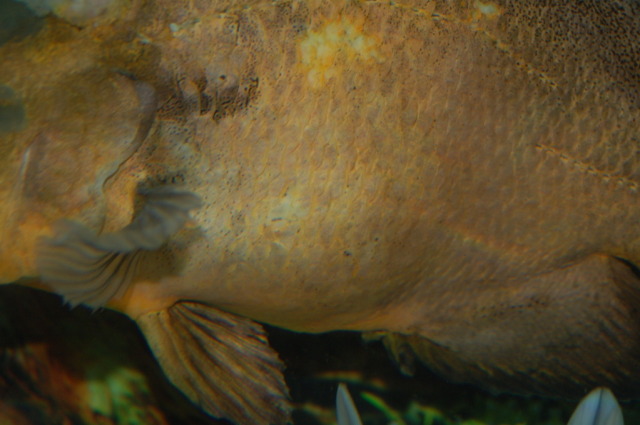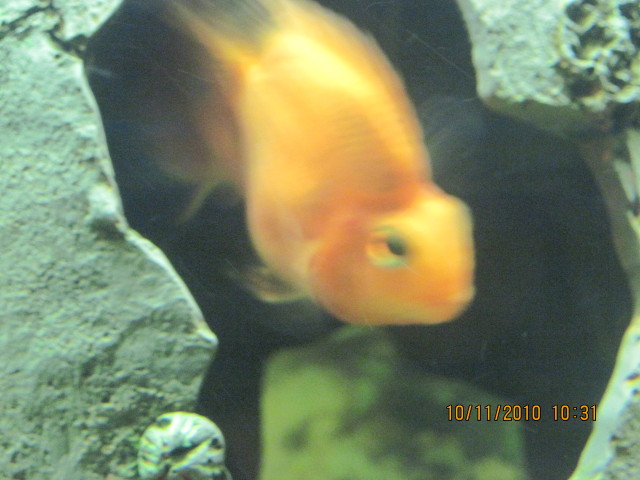Question*Hey there again. I tried directly emailing you through your website, but it's been close to a week and no response, so I thought I'd try asking you through this. Below is the exact email I tried sending you.*
Hello Professor Coleman,
My name is David Li. I will soon be in an advanced placement biology class. During the last year or so, I have been doing a behavioral study on Cichlids.Thanks a lot for the help you gave me in my last e-mail! My project won a category first place in my school, county, and region. However, I decided to further investigate the behavior and ecology of cichlids and I have a few more questions about the territorial behavior and biology of Convict Cichlids.
1. How does the territorial behavior of these convicts compare with the territorial behavior witnessed in raptors or even humans? Is it similar, based on the same evolutionary causes, etc.?
2. What would be an effective way to distinguish between males and females? I know that males are slightly larger and have more defined stripes and the females are rounder, but I just want to be more certain.
3. In observing two cichlids, I noticed that one of them was very protective of its home range. It changed color from its normal silver and black to blue, then chased the intruder away with a ferocity I have rarely seen in these convicts. Is this color change something I imagined, or is it a real ability of the cichlid?
4. Are reddish-orange spots on the cichlid a sign of disease or are they natural?
5. Sometimes when I go turn on the tank light in the early morning, I noticed that the a few convicts were almost pure white, almost no sign of any stripes, and internal organs were almost visible. Why is this? Is it a result of bad fish-keeping?
6. How large does a sample size have to be in order to have statistically valid data in a high science project that measures territorial behavior of cichlids? I will try to get numerically accurate data on how territoriality varies with population density.
On a side note...
In the post experiment mayhem of last year, a few of my cichlids ended up breeding. If the offspring "disappear, is it because they are devoured by other cichlids or is it a lack of being fed?
Thanks a lot for taking time to read my e-mail (I know this is a lot). I'm sure your response will be very helpful. You can contact me at davidli637@hotmail.com.
AnswerHi David,
I'm very sorry for the delay in responding. I've been giving exams all this week.
Did you write the project up in a report? I would really appreciate it if you could send me a copy. I am always interested in examples of students doing good science with cichlids. My mailing address is: Dr. Ron Coleman
Department of Biological Sciences, California State University Sacramento, 6000 J. Street, Sacramento, CA 95819-6077
Please include a cover letter saying what you said at the top of your email, i.e., that it won first place. This kind of thing is always valuable ammunition for me in trying to get more resources for teaching about fishes and behavior.
Anyway, back to your questions:
1. The motivation is the same, namely to protect resouces and/or the offspring. The goal of organisms is to get more copies of themselves into the next generation. Some do this by having lots of kids and letting the kids take their chances. Others have fewer kids and protect them fiercely. Cichlids, humans and eagles take the latter approach.
2. Exactly how to tell a male from a female convict is a fascinating issue. I have a student working on that right now. In general, females are rounder and have a more rounded face. Males often have longer fins, but not always. The funny thing is that someone like me who has worked with convicts for so many years can usually tell a male from a female, even at a small size, but I can't say exactly why I can tell the difference. This is what my student is investigating. We are using two-dimensional mathematical analysis of the shapes of males and females to see if there is a subtle mathematical difference that we can detect but we just can't verbalize. This makes some sense in that humans are very good at 2-D shape discrimination, e.g, we can easily tell different people's faces apart but we can't often say exactly how they are different, just that they are different.
The other big cue is that females often have orange scales on the sides of the belly whereas males very seldom do.
3. Cichlids often change color. They use color to communicate to each other, to potential attackers and to their kids. They can change color second by second. Convicts go particularly "contrasty" (the black becomes blacker and the white whiter) when they are guarding kids.
4. See #2. Females have the orange.
5. Fish sleep at night and they fade out their colors to blend in with the background. In the wild, they are so asleep that if I go snorkeling in the rivers at night, I can even touch the very large cichlids. They lie on the bottom or on ledges at the side of the river. It's very weird to see.
6. The issue of sample size is a tough one. Basically, it depends on how variable the data is. For example, if you measure the length of a bunch of pieces of straw and they all come out to within a half inch and you are only interested in the length to the nearest half inch, well then a sample of 5 to 10 will be fine and any more than that will be a waste of effort. However, if they vary by a foot or more, then you need to measure many more to get a good feeling for what the mean (average) would be. In other words, "enough" is when the addition of another data point doesn't really change the results.
That said, in behavior work, at a research level, I aim for a sample of ten in each group. So, if I was comparing two treatments, one with a low density of fish and the other with a high density of fish, I would want ten samples of each.
For a high school science fair, where you have much less time and resources, I would say five would be great. Three in each group would be fine.
Best of luck with your research. Sorry again about the delay.
-- Ron
rcoleman@cichlidresearch.com
Cichlid Research Home Page <http://cichlidresearch.com>

 Testing water quality
Question
My tank
I have a 45 gallon tank with 4
Testing water quality
Question
My tank
I have a 45 gallon tank with 4
 Another New-Age Cichlid Question
QuestionMy 125-gallon New Worl
QUESTION: Profess
Another New-Age Cichlid Question
QuestionMy 125-gallon New Worl
QUESTION: Profess
 Goldfish Issue
Question
Goldfish Image
Hi. My fish is a goldfis
Goldfish Issue
Question
Goldfish Image
Hi. My fish is a goldfis
 Lump On Oscars Side(s)
Question
Lump Bigger of Left Si
Hello I have an Oscar T
Lump On Oscars Side(s)
Question
Lump Bigger of Left Si
Hello I have an Oscar T
 fish indentification
Question
my fishy
i just want to know if u can tell me
fish indentification
Question
my fishy
i just want to know if u can tell me